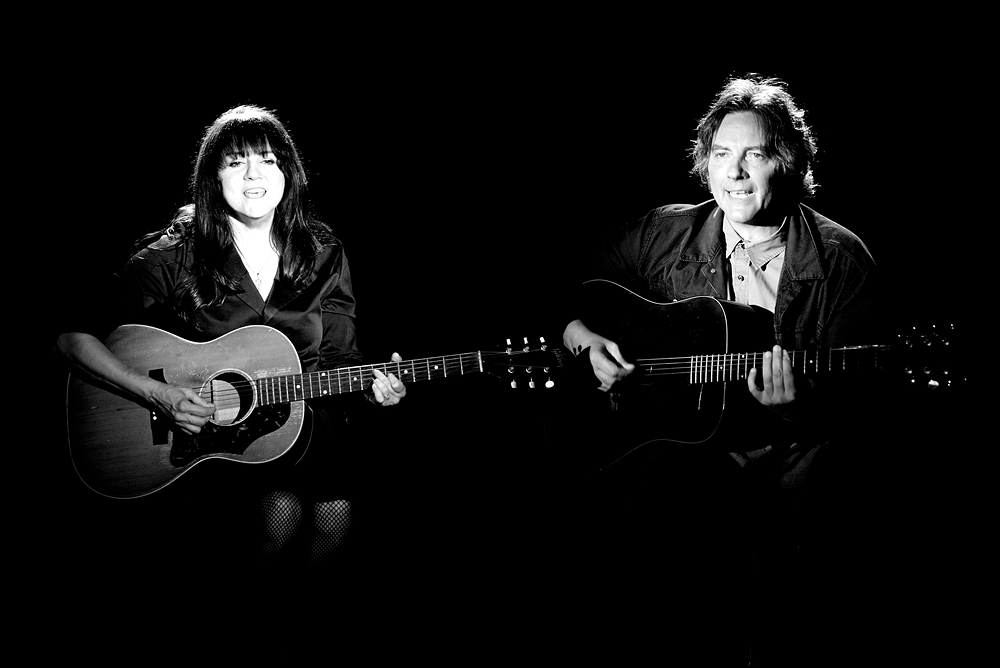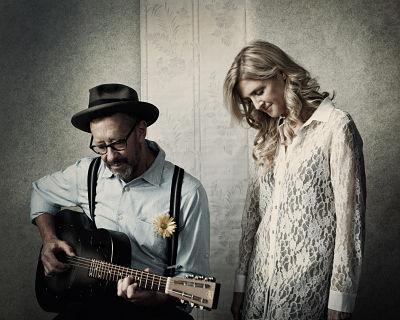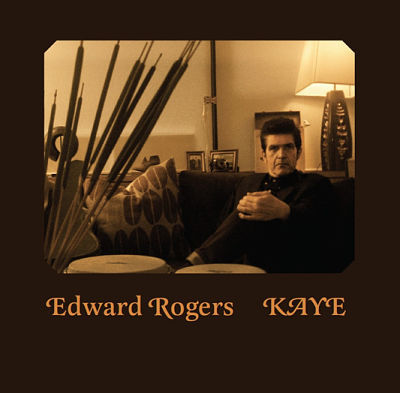GEORGE USHER & LISA BURNS: TOGETHER AT LAST FOR THE LAST DAY OF WINTER
This feature appeared in No Depression, November 2014
"I feel like I'm at my own wake!" proclaims a beaming George Usher from the stage of the sanctified Mercury Lounge in lower Manhattan.
With his latest musical partner Lisa Burns by his side, along with a crack backing ensemble comprised of New York City's finest, George Usher is indeed alive and well and co-writing some of the best songs of his long and winding career. The hallowed venue is packed with fans on a cool October evening, including a new admirer - Morgan Fisher of Mott the Hoople fame. Fisher greeted the co-band leaders, whom he had never met, in their dressing room minutes before George and Lisa delivered a set of songs that will eventually emerge as their highly-anticipated debut duo album entitled The Last Day of Winter. Usher, Burns, and their bassist Sal Maida –who toiled in Roxy Music and The Sparks whilst Morgan was plying his patented theatrical plinkery for the iconic Herefordshire ensemble, bestowed the gregarious Brit the title of "rock royalty" and afforded the dapper piano-man half- bows of reverence in his presence. Indeed, rock ‘n’ roll fandom knows no age limits! Which brings us to George and Lisa…
The folksy, autumnal, and ultimately celebratory song-cycle The Last Day of Winter is not quite the standard fare for Usher, who is among America's greatest indie-pop tunesmiths and recording artists. If you are unaware of his history be advised to research Mr. Usher's extensive and impressive rock 'n' roll curricula vitae. In 2010 Mr. Usher was diagnosed with cancer - which is the underlying catalyst of Winter - though the ailment is never directly referenced. Details George, "we call it a document of hope, friendship, and defiance in the face of crippling illness and potentially the loss of life." Treatments for the disease rendered George unable to do things that most healthy folks take for granted, including the ability to play an instrument.
"It's funny with a thing like cancer," reflects George, sitting in his West Village kitchen where he and Lisa created Winter, "I did not announce it on Facebook…there are some people who are still finding out about it! Other people, when they heard about my condition, they ran for the hills…but I forgave them immediately. Yet I had other friends who stepped up…"
Among those other friends who stepped up was Lisa Burns - a distinguished New York City songstress with a notable canon that includes her 1978 MCA self-titled solo album, plus such acclaimed releases as Unadorned (2004) - which won praise from Phil Manzanera and Russell Mael among others, Channeling Mary (2011), and New Randy (2006) with Holly Anderson, among many other musical projects. Note to readers: after you research Mr. Usher, investigate Ms. Burns!
George remembers "my cancer treatments left me walking around like a zombie…but I had to somehow speak to things, so I started composing lyrics. I also write poetry, however lyrics are different, they need to be 'mathematically and rhythmically correct.' Many times I'd written lyrics and given them to musical colleagues, but they didn't know how to do the 'Bernie and Elton' thing. It is particular talent all its own to write lyrics to fit a melody that has yet to be written, and to write a melody for lyrics someone hands you."
Enter Lisa Burns, who flourishes when penning melodies and chords to a fully realized libretto. "It's butter!" responds a rather modestly ebullient Ms. Burns. "I was grateful. I have so much melody. And George's lyrics suggested melodies to me. I was like a jeweler looking through a loupe at a gem -my job was to bring out the essence of his words in song." She pauses, "actually, if you are a songwriter, and you are open to it, having lyrics already written is an easier way of working."
At regular intervals the two would meet in the Usher family kitchen to exchange lyrics and for Lisa to perform the songs she had completed in chronological order for George - who was still incapacitated for extended periods of time during the writing process, and who was not always in the best of moods. Says Lisa "I was not intimidated -I was challenged - I wanted it to be my best work. One part of me was inspired by the fact that I had great lyrics, and the other part of me was motivated by the seriousness of the situation. We never talked about the meaning behind a particular lyric - I wanted it to be fresh and objective."
Usher: "whenever she came in with a finished song - I didn't expect it to be so good!" As George's health improved and he gradually regained his motor-skills to the extent where he could sing and play with Lisa, they commenced to demoing the songs as a matter of record with no intentions of making an album. That changed, though Usher initially envisioned their work to be a Lisa Burns solo collection. “I always heard these songs in George’s voice,” counters Lisa. Usher reveals “when we were working I had it in the back of my mind that this could be the last songs I’ll ever write.”
Because George's regimen was best served by not traveling, and as a matter of convenience, the duo recorded the album locally with an impressive cast of musical friends and family: bassist Maida (who, incidentally, is married to Burns and who reveled in the long-awaited opportunity to record with Usher); keyboardist Dylan Maida (son of Lisa and Sal); drummer Wylie Wirth (Dead Ex's); guitarists Captain Kirk Douglas (The Roots), Dave Schramm (The Schramms), Mark Sidgwick (Holly & The Italians), and Jonathan Gregg; among others. With Usher and Burns serving as their own producers, they brought Winter to resident Americana legend Eric Ambel of The Del Lords renown to render the mixing. As with all of Ambel's work, you can feel the band on record as if they were three feet away from you.
Emphasizes Lisa - "the album captures the magic of the performances - it's an extension of us playing in our living room. These songs are universal, at some point in everyone’s lives; we confront our mortality and have to deal with things like cancer. Even from the stage of the Mercury I could see people singing along to songs that they'd never heard before."
At present Usher and Burns are still shopping the album. However they have filmed a video produced by Spencer Gordon as a teaser, choosing the track "More Than That I Cannot Say." George refers to the song as the album's single, though Lisa reminds George that “45s” cease to exist in an official capacity.
Regardless, Usher can hardly contain his joy. "I can't believe I made an album with Lisa Burns!" George, who once labored at establishments known as “record stores,” proudly displays his vinyl copy of Lisa Burns' major label debut waxed during the Carter Administration, greatly admiring Ms. Burns’ sexy image which adorns the jacket, and which she still maintains.
"Wow! I love this album, and I really, really love the cover! They don't make album covers like this anymore!"
For updates regarding The Last Day of Winter release and upcoming George Usher & Lisa Burns shows, check in regularly on www.TheLastDayofWinterAlbum.Com
Video Link “More Than That I Cannot Say” : http://vimeo.com/106217636


